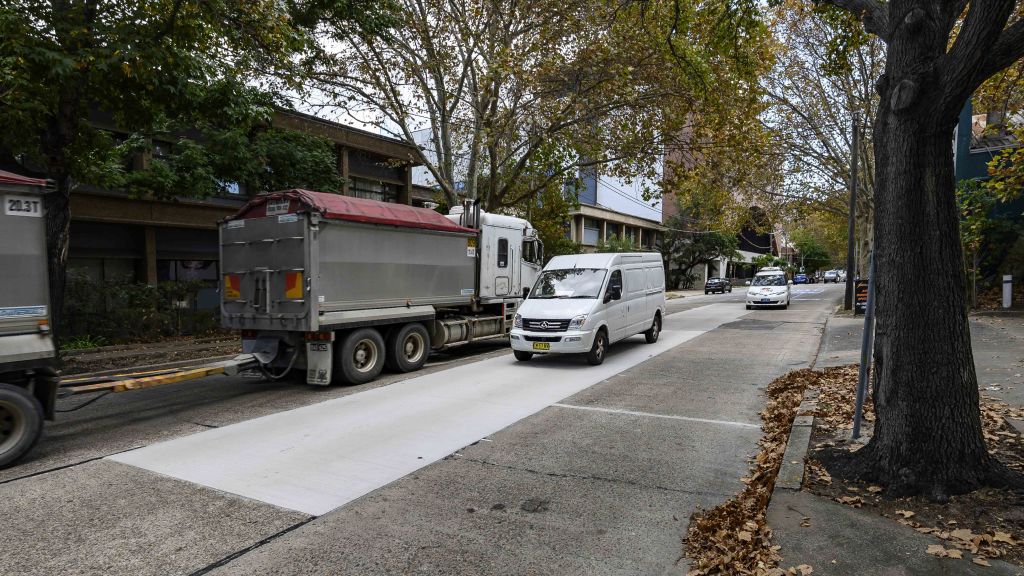Concrete made using industrial waste from coal-fired power stations and steel manufacturing is being used in a world-first green roads trial in Sydney.
The City of Sydney is putting the environmentally friendly building product to the test on a busy inner-city street, replacing a 30 metre section of roadway on Wyndham Street in Alexandria.
To test the green concretes durability, the City has laid a 15 metres traditional concrete and 15 metres of Geopolymer concrete, a sustainable blend of concrete and recycled materials.
As a major road leading to Sydney Airport, the high traffic volume provides the perfect conditions for the trial.
Nine sensors have been positioned under the concrete to monitor and compare how the Geopolymer concrete performs.
UNSW Sydney researchers and the CRC for Low Carbon Living (CRCLCL) will then use results from the trial to create the first set of industry guidelines for Geopolymer concrete.
Lord Mayor Clover Moore said the City was committed to finding new ways to lower carbon emissions.
“I’m proud that the City of Sydney was Australia’s first carbon-neutral local government and that we’re continuing to take significant steps to reduce our carbon footprint,” the Lord Mayor said.
“Projects like this Geopolymer trial can result in new products that make a real difference in slashing carbon emissions.
“Local governments are responsible for maintaining local roads, so if we can purchase more environmentally sustainable materials, we can fight climate change and provide quality infrastructure for our community.
“With 70 percent of the concrete produced today going into pavements and footpaths, there’s great potential to further lower emissions from our operations.
“We’re continually working with concrete suppliers to reduce the amount of pollution and greenhouse gases emitted during the production of concrete for our local roads, and we already use sustainable green concrete for all our footway renewal works – which adds up to 25,000m2 per year.”
Made from fly ash and blast furnace slag, Geopolymer generates just 300 kilograms of CO2 per tonne of cement, compared to the 900 kilograms from traditional cement production – saving the equivalent of the electricity used by an average household every two weeks.
Research has been undertaken since the 90’s into geopolymer, but it’s only now that it is being explored as a product that is not only better for the environment, but also commercially viable.
The low CO2 concrete has the potential to put the 400 million cubic tonnes of globally documented waste from the coal and steel industries to good use. While a small amount is currently used in construction, much of it is currently stored on site.
UNSW Sydney researchers will monitor the road performance for up to five years. Professor Stephen Foster, Head of School of Civil and Environmental Engineering, is the CRCLCL project lead and describes the trial as “a huge step forward”.
“This trial will help drive step change in the industry. Many concrete companies are already doing a lot to change, but this trial really gives it another push,” Professor Foster said.
“Research into Geopolymer has been undertaken since the 90s, but it’s only now that it’s starting to be commercialised.
“While we’ll monitor the road performance for up to five years, a lot of the data collected in the first three to 12 months of this world-first trial will be used to confirm our models and strengthen our predictions.
“Concrete contributes seven per cent of all greenhouse gas emissions and in 2018 the world produced about 4.1 billion tonnes of cement, which contributed about 3.5 billion tonnes of CO2.
“Alternative, low CO2 concrete materials offer potential benefits in reducing the greenhouse gas emissions associated with conventional concrete.
“This trial is important because we need demonstration projects to accurately assess the performance of Geopolymer over time so that there can be broader uptake.”
Industry partner Craig Heidrich, executive director, Australian (Iron and Steel) Association and Ash Development Association, says the benefits of the trial will be far-reaching.
“Our collaboration with organisations such as the City of Sydney and the publication of the research findings will further de-mystify and promote the use of Geopolymer concrete in construction.
“Geopolymer concrete has great engineering properties. It is a durable, high performance product that has a low carbon footprint when used in construction,” Mr Heidrich said.
“It's a fundamental tenet in business that you need to be constantly innovating and investing into new technologies. This trial will provide real examples of Geopolymer concrete use that we can all use.”
According to Dr Tommy Wiedmann, Associate Professor of Sustainability Research at UNSW, if all concrete was produced in one year was Geopolymer instead of traditional concrete, this would save 12,000 kiloton CO2 per year.
A timelapse video is available for use: cityofsydney.wistia.com/medias/c7xf397dx7
For media inquiries or images, contact Belinda Wallis.
Phone 0467 810 160 or email bwallis@cityofsydney.nsw.gov.au
For interviews with Lord Mayor Clover Moore, contact Jack Begbie
Phone 0481 759 580or email JBegbie@cityofsydney.nsw.gov.au
- Wyndham St geopolymer trial 1.70 MB
- Wyndham Street geopolymer trial 1.45 MB
